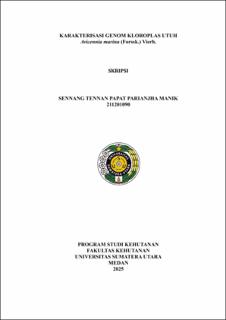Karakterisasi Genom Kloroplas Utuh Avicennia Marina (Forssk.) Vierh.
Characterization of the Intact Chloroplast Genome of Avicennia marina (Forssk.) Vierh.

Date
2025Author
Manik, Sennang Tennan Papat Parianjha
Advisor(s)
Rangkuti, Ahmad Baiquni
Indriani, Fitri
Metadata
Show full item recordAbstract
Mangrove forests are forest ecosystems that grow in coastal areas, especially in
tidal areas influenced by seawater. One species in this ecosystem is Avicennia marina,
which has a high tolerance to salinity and is able to grow in extreme environments.
Mangrove areas in Indonesia are under pressure from human activities such as land
conversion, pollution, and coastal development, so conservation and rehabilitation efforts
are needed. Genomic information, especially from important organelles such as
chloroplasts, can be a strong scientific basis for genetic-based conservation strategies. The
aim of this study was to characterize the whole chloroplast genome of A. marina using DNA
sequencing technology. One of the most widely used Next-Generation Sequencing (NGS)
technologies is Short Read Sequencing, which has advantages in terms of very high
accuracy and the ability to produce large amounts of data. The structure of the A. marina
chloroplast genome is circular, with a total length of 148,263 bp and consists of LSC (Large
Single Copy), SSC (Small Single Copy), IRa and IRb (Inverted Repeats) with 114 types of
identified genes. These genes include genes encoding photosynthetic proteins, ribosomal
proteins, tRNAs, rRNAs, and genes with other metabolic functions. Several genes
discovered, such as psaA, rbcL, ndh, atp, clpP, ycf1, and ycf2, play important roles in
adaptation to extreme and high-salinity environments. These genomic findings can be
used to identify adaptive population haplotypes, select parents for mangrove restoration,
and provide a basis for molecular markers for breeding saline-tolerant coastal plants.
Collections
- Undergraduate Theses [2162]
